




I am very excited about SAQA’s new book project, Art Quilts Unfolding: 50 Years of Innovation to be published by Schiffer later this year. Featuring the quilts of more than 200 artists, this publication includes interviews with 58 makers discussing their work and careers. I’d like to share with you a few of their inspirational remarks. This important book documenting the art quilt movement has prompted a special exhibition at QuiltCon 2018 in Pasadena, SAQA Presents: Modern Inspirations Art Quilts from the 1970s Through Today. We are also organizing a major touring exhibition, Layered and Stitched: 50 Years of Innovative Art. I hope you have an opportunity to see it. Look for updates at www.saqa.com/aqr.
Michael James: I like that my creative processes are unpredictable, somewhat mysterious. That when I go into the studio I’m faced with a very humbling enterprise: creating something from nothing in a sense.
Michael Cummings: To step back and see what your imagination has created is an exhilarating moment.
Jane Dunnewold: I love knowing how to make materials respond to what I want, which takes time to understand. But then, once I understand, I love what materials can do serendipitously. It’s an ongoing dance back and forth.
Nancy Erickson: I completed an M.F.A. in painting at the University of Montana, where the best piece of advice from a teacher was: “Just do it.”
Patricia Malarcher: Kenneth Noland, my first design teacher, influenced my approach to materials with his enigmatic statement: “Design is the way things are.”
Joy Saville: When people see my pieces, I hope that they find something relevant in my work and that they are inspired to be creative, too.
Studio Art Quilt Associates, Inc. (SAQA) is a nonprofit organization whose mission is to promote the art quilt through education, exhibitions, professional development, documentation, and publications.
©2018 Studio Art Quilt Associates, Inc. All rights reserved. Reproduction without permission is strictly prohibited.
SAQA Art Quilt Quarterly is published by Studio Art Quilt Associates, Inc., a nonprofit educational organization.
Publications Office: P.O. Box 141, Hebron, CT 06248.
ISSN 2379-9439 (print)
ISSN 2379-9455 (online)
Editor: Sandra Sider
Managing editor: Martha Sielman
Artists to watch contributing editor: Diane Howell
Collector’s bookshelf editor: Patricia Kennedy-Zafred
Designer: Deidre Adams
Circulation consultant: Peter Walsh
Subscription is $29.95 for four issues
Outside USA: add $12.00
Subscribe online: SAQA.com/AQQ
Cover: Origins by Janis Doucette 26 x 24 inches, 2017 photo by Steve Gyurina see story, p. 20
Over the years, Shelly Zegart has owned more than six hundred quilts, dating from 1830 to 2001. She purchased her first antique quilt in 1977, at a time when very few collectors even knew about art quilts, much less about where to acquire them. Zegart focused on collecting art, but the quilt as contemporary art was not on her radar. She collected the art of antique quilts, passionate about quilts that could “light her fire” and that really spoke to her. Zegart has a special interest in quilts with a human element that tell a story, creating a connection across time between maker and collector. Her personal quilt collection now resides in The Art Institute of Chicago.

A native of western Pennsylvania, Zegart moved to Louisville, Kentucky, in 1968. She became involved in Kentucky’s rich quilt heritage in the mid-1970s. Zegart co-founded the Kentucky Quilt Project in 1980 to discover and document quilts in the state, a project that became the model for similar research across the country. As an expert curator, collector, author, and appraiser, Shelly Zegart has demonstrated her superb eye for quilts. Because her 2012 DVD Why Quilts Matter: History, Art & Politics indicates Zegart’s affinity for contemporary quilt art, I asked her to create a dream collection from twenty or so artists working in the quilt medium. I inquired, “If you collected art quilts, what would be your choices and why?”
We can only show nine of Shelly’s choices, but we hope that readers will search for others on the Internet.
clockwise from top left: Joan Schulze, Self-Portrait 92 x 72 inches, 1985
Michael James, Ikon 79 x 74 inches, 1996

Kyoung Ae Cho, Aged: Covered by Wisdom 108 x 108 inches, 1996
Collection of John M. Walsh III
Having been involved with the famous Gee’s Bend quilt exhibitions that toured early in this century, Zegart has abiding respect and admiration for two generations of Gee’s Bend makers. Her favorite quilters from that area of Alabama include Mary Lee Bendolph (Mama’s Song, 2005), Loretta Bennett (Lazy Gal, 2017), and Annie Mae Young (Strips, 1985). Zegart’s taste does not differentiate between the functional yet original quilts of Young and the contemporary work from Bendolph and Bennett currently offered by the Greg Kucera Gallery in Seattle for as much as $13,000. To Zegart, they all fall under the rubric of abstract art.
Other quilts created in an abstract style are equally appealing. Zegart sees Yo Yolanda (1995) by Yvonne Porcella as the most “ethereal” of her quilts, and the story behind the piece amused her. As Porcella told it, “I used to shop for shoes at a San Francisco boutique. The owner knew I had a name that began with a Y but

always stumbled to find the right name: ‘Yo, ah, yo, hello, Yolanda!’”
Joan Schulze’s 1985 Self-Portrait caught Zegart’s eye with its “poetry of strange and surreal juxtapositions,” yet it was grounded by personal imagery: the cord from Schulze’s studio iron is printed in cyanotype. The abstracted narrative in this quilt includes, in the artist’s words, “a path leading to the unknown, a few mountains left to climb, and vast skies with room to soar.”
Like many collectors, Zegart associates works of contemporary art with other aspects of her collections and with art in general. For this reason, Ikon by Michael James, inspired in the mid-1990s by a Russian icon, is on her list. The commanding patterns in

this work remind Zegart of ancient Nazca textiles. She admires the mixed-media quilts of Kyoung Ae Cho, whose conceptual uses of wood open up conversations about age, time, and the very nature of quilts. Vivid hues in Jill Pace’s Tutti Frutti remind Zegart of her Bakelite collection, and Sigi Gertschen Probst’s minimalist Ohne Titel (Untitled) caught her eye with its echoes of prehistoric drawings. Zegart sees tantalizing hints of Vasarely in Waves by Annaliese Jaros, and Cinco de Mayo by Karen K. Stone resonates with her love of New York Beauty quilts. Representational quilts also interest this collector, especially with her love of narrative. Give us This Day (1996) by Joan Lintault offers a visual feast in a table laden with food, “exquisite and extraordinary surface design.” The human element is emphasized here, as in Hand Tools by B.J. Adams, which features hands reaching out for various tools, and in Terrie Hancock Mangat’s Lake Superior Stick Bed Quilt incorporating an actual bed and referencing environmental issues in our lake ecosystems. Natural imagery infuses Jane Sassaman’s
clockwise from top left: Jane Sassaman, Wreath 22 x 22 inches, 1996
B.J. Adams, Hand Tools 46 x 75 inches, 1998

Collection of John M. Walsh III
Marilyn Henrion, New York Windows 1434 24 x 18 inches, 2014

photo by Jean Vong
Terrie Hancock Mangat, Lake Superior Stick Bed Quilt c. 1996

Bed: 80 x 45 x 42 in.; quilt: 78 x 64 in.
Collection of the International Quilt Study Center & Museum, University of Nebraska, Lincoln


opposite:
Susan Shie and James Acord
The Water Quilt: A Green Quilt for Peace
91 x 64 inches, 1991
collection of Eleanor A. McCain
below, left:
Betty Busby
Armadillo
12 x 12 inches, 2011
below, right:
Sidnee Snell
Working Title #5
12 x 12 inches, 2008
How do you get started as a collector of fiber art? For many people, the journey begins with one piece that speaks to them on an emotional level. For others, it’s the opportunity to own a piece by an artist they admire or to add something different to displays of their own artwork.
Carol Larson, a mixed-media textile artist from Petaluma, California, began collecting Navajo rugs during trips to the Southwest a number of years ago. In the past 10 years, she has added art quilts to her collection for contrast and color. She looks for work that provokes an immediate response because of composition, color, media or a combination of all three. “I see it. I love it. I want to have it in my home,” Carol said.

Eleanor McCain, an artist and collector from Shalimar, Florida, began her collection by purchasing work she admired

from a gallery show she attended in Atlanta in the mid-1980s. This included pieces by artists Pamela Studstill Quest and Susan Shie.
“I’d never seen anything that exciting,” McCain said, adding that she went back to see the show every day for three days to absorb it all.
How many pieces make a collection? If you own more than one art quilt made by someone other than yourself, you may have the beginnings of a collection, even if you don’t yet think of yourself as a collector.
A good starting place is the annual SAQA Benefit Auction, where you can choose from hundreds of 12x12-inch pieces of art. Shirley Neary, an artist and collector from Omaha, Nebraska, has an extensive
collection of fiber art, much of which she has purchased from SAQA auctions and exhibitions.

“SAQA plays a huge role in my collecting,” Shirley said, explaining she enjoys supporting the organization and is drawn to the high-quality work and reputation of the artists.
Carol Larson takes advantage of the fact that the auction quilts are posted on SAQA’s website for several months before the September event.
“I preview all the quilts in the auction before it starts, making note of the pieces I respond to viscerally,” she said. She consults those notes as she decides which pieces to bid on.
For Shirley, going to art exhibitions is a key part of the process.
“I go to art exhibitions to see lots of art, and occasionally, I buy from those,” she said, noting she


collects paintings, drawings and folk art in addition to fiber. In one instance, she sought out an artist’s studio while traveling and purchased a piece directly.
Art quilt collections are as varied as the people who own them. Some have a particular focus, such as Carol’s collection of pieces that are blue and/or have circles in the design. She purchases these artworks for her office/guest room.
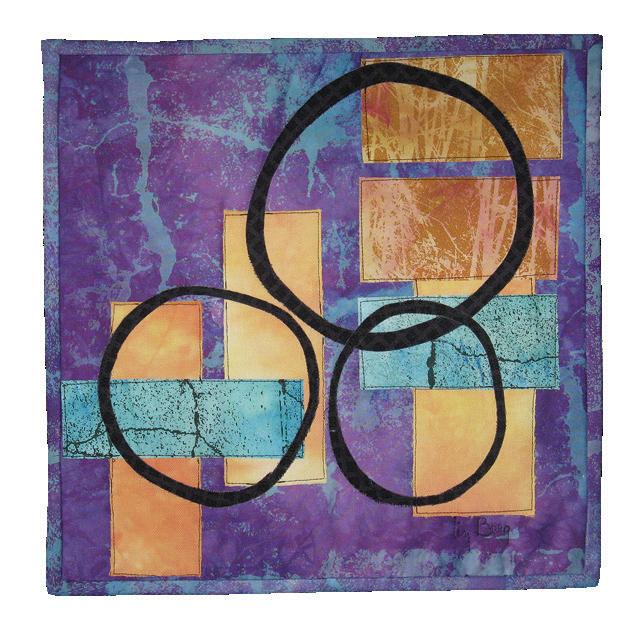

Laura Krasinski, an artist from Menomonee Falls, Wisconsin, enjoys collecting pieces unlike any she makes herself, such as abstract or mixed-media work.
For Shirley, it’s important that the work be something she won’t get tired of looking at. “As an artist, I appreciate the design and workmanship, and more importantly, the ideas, in each piece that I collect,” she said.
Collectors generally don’t buy art to match a living-room sofa, although some start out with decorating in mind. Collectors of fiber art don’t buy work as an investment. A collector from the Washington, D.C., area, who prefers to remain anonymous, offers this advice: “Think of your purchase as a piece of beauty that you find enjoyable, that you want to look at many times every day. Think of it as food for your soul.”
Most collectors at some point face the issue of space. When Shirley found her collection had expanded
“
beyond space in her home, she opened a storefront showroom in Omaha to exhibit her collection.
“I began to collect for my personal enjoyment and support of SAQA,” she said. “Then my purpose evolved to the idea of sharing my collection with Omaha and the surrounding area.” She operated the showroom for two years before closing it in December 2012 to free up time for other pursuits.
The Washington, D.C., collector advised not worrying too much about space: “You always have more room on your walls, or if necessary, you can take some pieces down and put others up. You will see different aspects of the art when it is in different settings so move it around.”
Collectors also consider budget. Laura recommends starting by buying small pieces, like fabric postcards or small wall pieces. “For me, such pieces are affordable, and I can always find a place for them on one of my walls.”
When Eleanor came home from that first gallery show, she went to the bank and opened a savings account earmarked for purchasing art. A year later,
she was able to return to the gallery to buy her first art quilt. She recommends adding a set amount to an art account each month; soon you’ll have funds to begin, and then, to add to your collection.

Once Carol has created her preview list of SAQA auction pieces, she decides how much she will spend during the auction. Her budget helps her winnow her wish list. Since it’s a reverse auction, the price of each piece starts at $1,000 and drops each day until pieces are $100 each at the end of the auction week. Waiting for the price to drop involves risk. The work you want may not be available at the price you’d like to pay.
The first year Carol participated in the SAQA auction, she waited until the price dropped, then bought two pieces. Another year, she fell in love with a piece by New Mexico artist Betty Busby and decided to buy it early.
“For me, making the list based on my initial responses helps keep me focused on the prize, so I don’t jump into the fray of bidding as a competitive sport,” Carol said.
Eleanor said that it has become more difficult in recent years to find pieces to buy as galleries have
 by Lori Lee Triplett
by Lori Lee Triplett
Conceptual artist John Lefelhocz has redefined textile arts, quilts, and the material that comprises his art. Initially inspired by a quilt show, he began exploring non-textile materials like dental floss, window screens, and sugar packets to form layers. His work consists of non-functional quilts inspired by other artists. Not since M.C. Escher has an artist explored tessellations to such an extent. Other artists

continue to provide inspiration. Lefelhocz uses their artwork as a springboard to create a series of juxtapassions (juxtapose/passion) with his own modern-day perspective. I sought answers from the artist to explain his beginnings, process, and new creations.
As an artist, you work in a variety of mediums. What got you started in the medium of quilting?
I enrolled at Ohio University in 1985 and stayed here in Athens, Ohio, after school. My wife had been to Quilt National here in town and was telling me to go and see it, stressing how good it was. I didn’t pay much attention to her. I missed the show that year, but went to see the next QN exhibition. I was impressed with the different artistic messages, media, and approaches to the medium. After seeing the show and the entry form, I asked myself, “How would I make a quilt?” My first quilt used alternative materials (window screening and sugar packets). That work was part of Quilt National ’99 and it got the quilt thing started.
What keeps you coming back to quilting, creating in this particular art form?
I’ve tried to adapt some of my process and style to other media, but the quilts somehow come out stronger. I have this conversation with other quilters and ask if they have a similar experience and usually it’s true. For some reason I’m able to create more depth with the quilts. For me, creating is complex, and I don’t have a set way or process.
above:
Money for Nothing

33 x 73 inches, 1998

opposite: The Awefsome Face Painting of the North Coast Mona Lisa
64 x 64 inches, 2013
(“awefsome” = awful + awesome)
I think several factors contribute to quilts being my preferred medium. In art school, I had a hard time choosing one area of study to focus on. Back then, when I mentioned that I wanted to be multi-disciplined, a professor told me that I would not be taken seriously unless I chose one specialty. Encouragement to combine disciplines is more prevalent now, and I think quilting is a great medium for this. It allows me to explore painting, collage, sculpture, fiber, and whatever else I can think up.


Your work seems to have clear connections to artists who have gone before you. Do you make conscious decisions to explore other artists’ work?
Yes, I enjoy revisiting and recombining upon the works of others. Creation always starts with building on something else. Where things get interesting for me is the exploration and dialogue about what these works meant to the artist and viewers when it was created, and what the art means to us now.
Do you consider your body of work to have phases? Are you conscious of those phases or is it something apparent in retrospect?
There are phases to my work, but it’s not a matter of “back then I made things like that, and now I make things like this … .” It’s more like a car radio in that there are buttons I can push and create a work that’s tied to a previous body of work. When the music is played out, I can push another button for a new style of work. I can’t always say what the next work will be like, but it will have ties to previous works.
Process for me is pretty loose. Sometimes I start with a quote or a certain material, or a general idea, and build off that. Frequently I’ll work an idea to the point of overworking it, and out of the blue, a completely different, much simpler, more elegant idea will surface. With new ideas, I’ll research and test how I want to construct the piece. Sometimes this takes longer than the actual production of the work.
Currently I’m incorporating LED lights into my quilts. I’m using computer programming to control the lights, employing a noise generator originally designed to make video game graphic textures appear less machine-like and more natural. Combining random scale, color, and animation speed, I can create a light sequence in which the animation will virtually never repeat itself. This approach produces a lighting sequence which is neither completely deliberate nor completely random, but somewhere in between. The quilts are animated and, being random, have neither beginning nor end.


To learn more about John Lefelhocz and his work: www.juxtapassion.com
41 x 75 inches, 2016
Janis Doucette is a lifelong maker. Her devotion to art quilts brings together a host of techniques to delight both maker and viewer.
Along her artistic path, Doucette learns about herself and the connectivity of all that is around us



The Crazy Quilters of Cape Cod (in Falmouth) included a number of quilt artists. As soon as I saw what they were doing, that was it for me! I had already begun to make my own art quilts in my signature grid style. After one art quilt class at Tumbleweed Quilts (in West Barnstable, Massachusetts), I was off and running.
I have always been attracted to dyeing and printing fabric. I did early tie-dyeing and made my first batik tunic when I was 18 or 19. I batiked pillows for both of my sons. My grandmother taught me to embroider and to tie off her quilts. All of that makes me a lifelong maker. I like the tactile experience of working with fiber. Dyeing and printing
the fabric that I use heightens this aspect and deepens my connection to my work. Occasionally I dye or print fabric for a specific piece, but usually I play with the fabric for its own sake and audition my hand dyes as I would if they were commercial fabrics. Occasionally, I love a piece or a batch of prints so much that I like to linger in thought about what to do with them. I tend to hold on to these pieces of fabric until serendipity brings something special to me. Senses of the Fertile Soil is an example of this open-ended process.
Although I rarely plan every step, I do a fair amount of research for most of my art. Once I turn away from the research, I quiet my mind
above left:
Gestation
35 x 26 inches, 2016
above:
Stratified
36 x 12 inches, 2017 photos by Steve Gyurina
and focus on my subject. I begin by pulling together fabrics by color, value, and pattern, although that’s more or less a subconscious process. I am so visually oriented that most of what I’ve learned over the years is at work without too much deliberate thought in the beginning. Sometimes I stay in this intuitive mode throughout a work’s creation.
I struggled through the making of All’s One Under the Sun, encountering issues with the imagery, composition, the message, and the materials. I must have made three or four different pieces and ripped them all up.
As I worked on my entry for the SAQA Concrete & Grassland exhibition, I thought it would be a piece of cake because I often combine images of nature and architecture. Not so! I was all over the place. I was frustrated and disappointed in myself, but I don’t like to give up. I kept at it, playing with my own photos of trees, leaves, grass, water, and so on, along with houses, buildings, cars, bridges, and basic artifacts. I started to get into a groove and found myself repeating the mantra: “All’s one under the sun.”
I realized I was thinking that all things made by humans are derivative of nature. There is an inseparable correlation between the two. God’s hand is expressed in the natural world, and, as the individuals
top: All’s One Under the Sun 2 14 x 23 inches, 2015
above: Across the Pond 30 x 23 inches, 2015

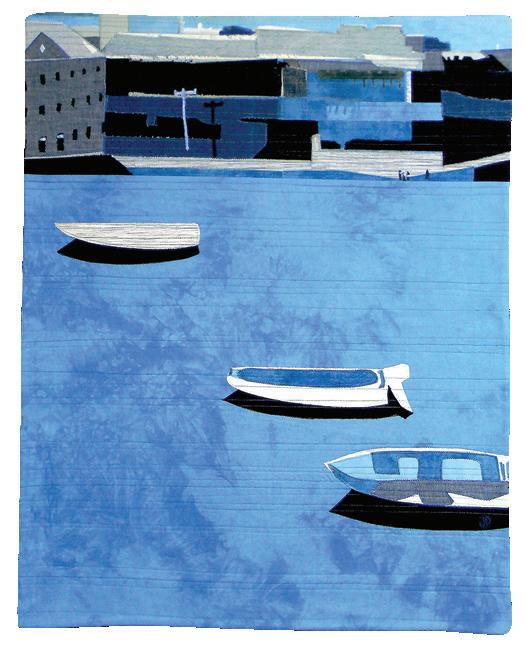
we certainly are, humans interpret the master. Case in point: my snow-dyed fabric melded perfectly together with photos of bridges, boats, and highways as well as with images of water, leaves, and trees.
Just as I began my art quilt journey in full experimental mode, I will continue to stretch and explore. I find myself beginning to settle into a voice that’s more recognizable than it was in the past. I am most comfortable working in a grid format, although I occasionally break out of it. I have moved beyond obsessively trying out new techniques and have found my own way to combine print with photography, dye, and paint on cloth. I am now more able to concentrate on the substance of my subject.

Painting and mixed media came early in my life; the first signs of morphing into art quilting came in 2006. I still play with various mediums that will invariably find their way into my fiber work, and I often move back into paper or some other substrate. Paper is a good medium in which to try things out before committing to cloth. It seems a natural progression to me to move from photo and print to fiber, especially when so much of my printing is now with pigment and dye on cloth.
I always challenge myself, and I learn something with each piece I make, in a thoroughly organic process. What doesn’t come so easily is marketing. I will try to show more of my work to more people.
The series Liminal States and Thresholds for Change is close to my heart and was born out of my own search for voice and artist identity. That series is ongoing.

My art comes from a continual renewal springing from within. It’s there through no fault of my own. I was born with this urge and it constantly needs to be fed and released. I only hope that I do worthwhile things with it.
www.turtlemoonimpressions.wordpress.com
When Helen Godden accompanied her mother to a quilt show more than a decade ago, she had no idea she would discover a new career as a quilt artist after watching a machine-quilting demo.
Today, she is an accomplished educator and award-winning artist whose work is recognized internationally. Her fine-art background allows her to combine drawing and painting with intricate machine quilting. Every quilt she sends into the world carries a piece of her with it.


I have been a full-time artist since I was 21, working in pastel, watercolor, and acrylic. I also painted ladies’ fashions commercially. My first encounter with quilts was at a quilt show, where I watched someone demonstrate free-motion quilting. I had no idea a sewing machine could stitch in any direction and be used to draw, doodle, and create shapes other than straight seam lines.
Why was I at the quilt show? I came with my mother after my only child was born. My mother’s goal was to redirect me toward fabric and sewing or quilting as both

distraction and therapy. She thought it would be a break from the solitary work in a home art studio. I also was emerging from postnatal depression, and my husband had fallen 40 feet from a cliff while rock climbing. He survived after three months in the hospital, many surgeries, and rehabilitation.
I have so many ideas that a theme helps me to decide which idea to pursue next. My daughter is featured in a few quilts. I love strong design, color, and storytelling. I love Australiana and find Aussie birds to be an endless source of inspiration. Sometimes a line from a song or a funny comment can create an image in my mind so strong it sparks a new direction.
New techniques and doing things my own way are also driving forces. The CreaCtive Process (the ACTIVE process of creating) is what I most enjoy. Making up new words is also a hobby.
My work is always varied. While it does not have a single unvaried style or technique, my work does have hallmarks: painted, colorful, and heavily quilted. Strong design elements exist on a pictorial storytelling base. I combine painting and quilting and rarely do
traditional framed art or appliqué. I never play by the rules.

I was fortunate to begin receiving recognition early in my career. In 2006, I won the Master Award for Innovative Artistry at International Quilt Festival/Houston for Mekong Gold. That was my second year to enter the Houston competition. When the quilt sold to a stranger for a serious price, I felt like a real artist for the first time.
I have taught sold-out classes at Houston for the past five years. In the past 12 years I have had 24 pieces displayed there; half of them earned an award.
For the past 10 years, Handi Quilter has been my sponsor. This Utah-based manufacturer of quilting machines established me as its international ambassador during my second year as a quilter. Their backing allowed me to be the catalyst for the availability of Handi Quilter products in Australia and in 85 countries outside the United States. I also invented a free-motion couching foot for the company that allows yarns and other fibers to be stitched directly onto the quilt.
Another bright spot in my career was winning the Fine Art Quilt Masters category in 2009 at The Festival of Quilts in Birmingham, United Kingdom, for Mother Earth

Whenever people tell me that I inspire them to create, I know that I have reached my goal to share my knowledge. My classes introduce students to painting and stitching on a quilt as well as help hone their machine-quilting skills. One of my machine-quilting classes, Escape the Ditch: Empower Your Quilting, is available on the Craftsy website.
One of my greatest joys is that I have passed on my passion for creating art to my daughter, Ineka.
As my work evolves, some collectors wish to capture a piece done in one of my particular styles. I also find that people love to own a small piece; my commercial art background enables me to create smaller works at a market price. I also take commissions.
I want people to enjoy looking and “reading” the story my work tells. I hope they enjoy the colors and understand that there is a little piece of me in the quilt. Each quilt represents a creative process in which I totally immersed myself, enjoyed, lived, and breathed for the weeks it took to complete. I liken the finished quilt to a snapshot of the process.
I hope people enjoy the end result and know that it is all genuine, all me. Every piece has much thought, passion, and effort that comes from within, from a place that is sometimes difficult to understand, sometimes overwhelming, sometimes frustrating for even me to comprehend, yet always invigorating and essential to my everyday world.
In addition to more online teaching, I want to create more large works and explore more techniques such as Paintchwork (painted patchwork), which of course also allows me to invent more new words. I want to continue to present students with possibilities. I will never say never and will always enjoy what I do to feed my creative soul.

www.helengodden.com
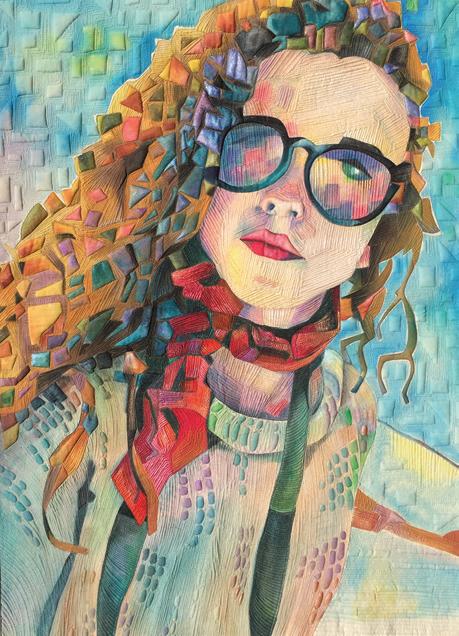
The art-quilt movement fits perfectly with the portraits I envision. It’s exciting to think that I can create a look that takes advantage of the painterly qualities of thread and fabric, melding them into a combination of tradition and innovation. My stitched portraits have evolved from simple appliqué and piecework to intensely stitched, dimensional faces.
Art quilts can effortlessly blend tradition and innovation, a combination that allows Rocke to introduce today’s viewers to people in vintage photographs.
Rocke’s images derive from many sources, ranging from family albums to photographs won at auctions, where strangers’ lost memories give flight to imagination. With just a glance, the photos suggest tell-all tales. Rocke’s interpretations of the gazes captured in these photos please the eye and focus the heart. Every work begins with a story.
My inspiration comes from family albums, vintage photos, and a blue-and-white hatbox of pictures I won at an auction. There is a mystery to the anonymous figures. These photos, kept and treasured for so long, represent a remembered time or feeling, a person, an emotion. Who were they? How old were they? Where were they and when? The storyteller in me wants to bring them to life. I get to tell any story I want, to create a world, a time, or an emotion through fabric choices and an interesting face. I hope to draw the viewer in to wonder about the subject.
I add images to the hatbox as I find them. The new sources include a cache of photos that were in my dad’s basement, my own albums, and treasures I find as I troll through bins at antique stores or at auctions. I’m always on the lookout for someone looking back at me.
Family is the thread that runs through most of my work. As a means of coping with loss, celebrating joy, or remembering childhood, my pieces become the story that I want to tell.
During my mother’s losing battle with ovarian cancer, my work with fabric and thread was a soothing break. I created a portrait of Mama when she was young using 1-inch squares held together, like me, only with quilting stitches. After she died, I entered the piece, titled Barbara Ann, into one of my first national quilt exhibitions, Quilts=Art=Quilts 2008 at the Schweinfurth Memorial Art Center in Auburn, New York. It was accepted and won first prize, which encouraged me to continue.

above:
The Haircut
18 x 54 inches, 2014
right:
Play Fair
33 x 18 inches, 2015
My pieces have evolved from simple, almost cartoonlike figures to more realistic appliquéd portraits. From there, appliqué with increased threadwork creates a more painterly image in fabric and thread.


I use photos from many time periods as inspiration. I have found that even when I create contemporary portraits, they often have a nostalgic feel to them, which may be my rose-colored view of the world.
When using any image, my intent is to let it be the starting point of the story. I strive to let viewers explore the piece. I want them to look at the work and ask questions, make suppositions, and create their own narratives.
When considering ideas for a portrait, I’m drawn to a subject’s pose, gaze, or perceived emotion. The photos may be old and are often very small, some about 2 x 3 inches. I copy and enlarge them enough for me to see the details. I then create a drawing or two, often by combining more than one photo to create the basis for a piece. Once satisfied, I enlarge the drawing close to the size of the envisioned work. This becomes a layout reference and my appliqué pattern.
I create the face and figure first. Through the process of laying down thread, I discover the planes of a subject’s face and the direction of the person’s gaze.
This makes me mindful of how densely to stitch certain areas. The extreme quantity of thread can create distortion. This outcome is often to my benefit, but it can create ghoulish effects. My assembly process includes various appliqué techniques.
I believe that those who have purchased or commissioned a piece by me have an emotional reaction to the subject matter, be it nostalgia, joy, wonder, or whimsy. It can be the viewer’s interpretation of a time or an event, or a reaction to why it was made.

Commissioned pieces have included full-sized quilts, wall hangings, and portraits. Among the portraits were newborn babies, three generations of women, newlyweds, grandmas, families, siblings, and dogs. Commissioned work stretches me. There are expectations on both sides. The client has an emotional connection with those in the portrait and wants to see that same feeling in the finished piece. I have a responsibility to communicate my artistic vision and my limitations. I strive to

communicate the idea that this is art, my own interpretation of the original image.
My interest in art quilts endures because they express the voice of an individual. Say “art quilt” to five different quilters and you will get five different visual images and definitions. We are all quilters using techniques, colors, subjects, and fabrics, yet the rules are loose or nonexistent. The field is broad and exciting.
With the completion of my latest piece, Cousins, which contains four portraits, I plan to return to studies of a single person on a neutral background looking out at the viewer. In this way, I can concentrate on the subject’s gaze and strive to make that person timeless. I am intrigued by people’s faces, both young and old. There is a mystery to them. There is a story there. The fun part of what I do, besides the work, is to tell a story. Some I know, some I make up, and some are a mystery and everyone loves a mystery.
www.lorarocke.com
above: Cat-in-the-Cradle 23 x 37 inches, 2015
below: Catfish Stringer 16 x 20 inches, 2014


Isabelle Wiessler’s artwork has one constant: textiles. After that, this mixed-media artist considers any and all possibilities. She combines paint, artificial materials, and a host of techniques to produce moving artworks in several different series, including one that finds beauty in tragedy.

One of her goals is to increase awareness of fiber art. To that end, she teaches, takes part in exhibitions, and continues to find new topics on which to base her work.

I discovered patchwork by chance 25 years ago through an exhibition in a bank. What impressed me most were the immense possibilities quilting offered. I started to work with traditional patterns, which I modified and later left behind.
The creative process involved in working with fabric and needle inspires me to regard fabric as a basic material and a point of departure, thus enabling me to combine my passion for fine art with textile art. I use whatever I need to realize what I want to express.
I started in the early 1990s with traditional quilting. Soon after that I started working on my own designs. In 2007, I dared to apply paint on cloth, which was a risky step in the quilting community in Germany. A major inspiration came from my discovery of the
work of Colorado artist Deidre Adams, who creates stunning pieces.

Today I would describe myself as a mixed-media artist with a passion for texture, surface, and space. I am fascinated with lines, shapes, and structures, and the endless ways these elements can be created with stitching and mark making.
I start a new series when something captures my interest. For example, in 2010 a newspaper photo of the Deepwater Horizon oil spill in the Gulf of Mexico grabbed my attention. It was surprising to see how a
horrible environmental disaster could be beautiful. That experience gave me the desire to work on the topic of ecological disasters and the controversial beauty found in those moments.
I do work on several series at once, but when I undertake a new theme, I make three or four pieces for it without the distraction of thinking about other concepts. I start with several sketches. Then I choose one and develop it into a stitched and painted work. My sketches help me understand the structure I want for new work and how to build it.
Painting and stitching are the most significant elements in my artwork. Most of the larger pieces are painted after the stitching is done on self-dyed cotton whole cloth. The painting process gives me the possibility to create a completely new structure by adding a third dimension. On the other hand, depending on the theme, I sometimes prefer to work on synthetic material such as Lutradur®, Tyvek®, or WonderUnder® to create interesting structures. These materials can be first painted and then layered, bonded together, and eroded with a heat tool or soldering iron. I love to work with them to depict worn surfaces like stones, an old roof, or tree bark.
My first milestone was the Judge’s Choice award for Springtime Forever (not pictured) in the 2006 Husqvarna Viking competition Imagine That, first exhibited at the International Quilt Festival/Houston. This prize was added by Husqvarna to acknowledge my entry.
In 2011, my work was on exhibit at the European Patchwork Meeting in Sainte-Marie-aux-Mines, France. Through this exhibition, I became better known throughout Europe and have since received many exhibition invitations.
In the summer of 2016, I spent two months as an artist-in-residence in Switzerland as part of the Artbellwald program based in the municipality of Bellwald. I was the first fiber artist selected into this program, living in a typical village in the Alps with

my own apartment and studio. I was able to work on my art for two months without worrying about anything else.
My goal is to get people to appreciate fiber art. This means finding exhibition opportunities in places where visitors are not used to seeing this art form. I also like to participate in quilt shows in Germany and throughout Europe to promote my own art and classes. This exposure provides invaluable networking. I only exhibit one series at a time, which I think makes more sense to the viewer.
I received an invitation to exhibit and to give classes in Mexico City in February as part of Expo Patchwork and Quilt 2018 produced by Quilters de Mexico®. I will also exhibit in Germany, France, and Holland next year.
My artwork often originates from photographs. It is a synthesis of what I see and feel: sometimes literal, sometimes abstract. My aim is to give viewers the opportunity to see what they want to see in my work.

In the future, I will continue to explore the many possibilities on the theme of trees and tree bark, as well as the inspiration for my Color to Light series. That alone seems like a life’s work! I also am interested in focusing on details of things we see but don’t pay attention to, and the effect that time has on those things. Deconstructed details may become an entirely different, abstract result.
To me, making my art is like breathing. Creating it is so important that I love to explain why I paint on cloth and how it is a valid art form. This is my voice.
www.isabelle-wiessler.de
above right: Surface 3 51 x 34 inches, 2015 right: Fading roof 20 x 20 inches, 2016
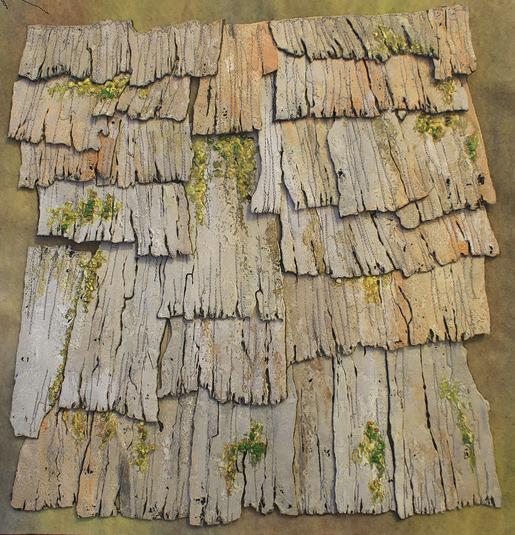
SAQA artists were invited to draw upon the scope of historic posters and contemporary iterations. The artists’ cloth interpretations could reflect advertisements for products, places, or events; be employed as a way to educate on topics of historical, social, or cultural significance; or otherwise communicate using the language of posters. Posters should grab the viewer’s attention and attempt to convey a message that can be heard above the incessant demands of other media.
What all have in common is an emblematic economy of text and imagery. Posters are meant to convey a message in the blink of an eye, be it to inform, educate, or persuade. It is that particular aesthetic consideration which characterizes these textile artworks.



 Shannon Conley
Mammals of Oklahoma
48 x 32 inches, 2017
Photo: Michael Cox
Cat Larrea Shiprock
48 x 32 inches, 2017
Claire Passmore
Shannon Conley
Mammals of Oklahoma
48 x 32 inches, 2017
Photo: Michael Cox
Cat Larrea Shiprock
48 x 32 inches, 2017
Claire Passmore



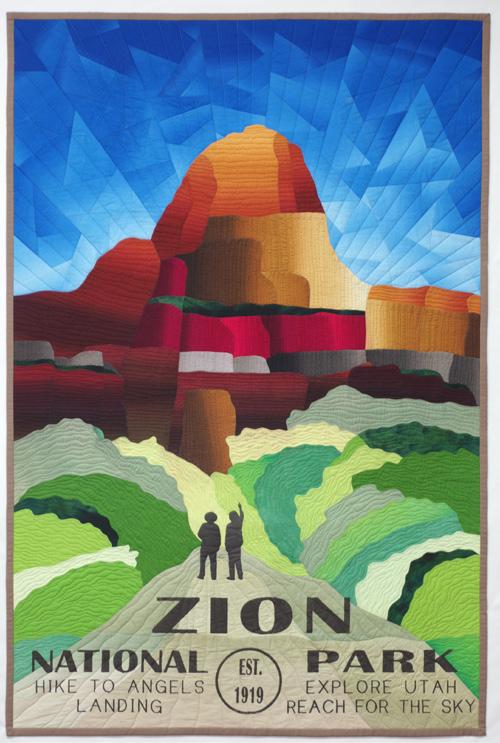 Christina Blais Le Chien Blond 48 x 32 inches, 2017
Photo: Donna Callahan
Betty Busby I Will Not Be Silenced 48 x 32 inches, 2017
Louise Hall Pardon Snowden 48 x 32 inches, 2017
Vicki Conley Reach for the Sky 48 x 32 inches, 2017
Photo: Doug Conley
Christina Blais Le Chien Blond 48 x 32 inches, 2017
Photo: Donna Callahan
Betty Busby I Will Not Be Silenced 48 x 32 inches, 2017
Louise Hall Pardon Snowden 48 x 32 inches, 2017
Vicki Conley Reach for the Sky 48 x 32 inches, 2017
Photo: Doug Conley
Curating In Death at the Wisconsin Museum of Quilts & Fiber Arts (WMQFA) was truly a journey. On view in 2017, this exhibition of 18 quilts plus 8 other objects originated with former WMQFA curator Jamie Henry. He selected the artists on the merit of their portfolios, allowing the makers to explore their deeply personal interpretations of death and dying within themselves and their art. Some chose to re-purpose pieces from their past, while

others created new work. I supported them every step of the way and intervened only when asked. As a curator new to the museum and never having previously worked with any of these artists, the task was a challenge, but I trusted Jamie’s expertise and my own instincts.
I was amazed to see the results and knew that we were on to something special. Instead of the dreary monotone palettes and platitudes I feared would
surface, I witnessed a burst of color and poetry. I am very proud of this exhibit and believe that its limited viewing exclusively at WMQFA was imperative to its narrative. I was happy to witness our responsive audience. Visitors engaged with the exhibit in a variety of ways, but always strongly. In Death provoked dialogue as well as leaving some viewers speechless. Such varied visceral reactions are exactly what any curator hopes for, and this success was thanks in large part to the talent and emotional openness of our featured artists. Let me share a few of their statements with you.
In Leaving, Jill Kerttula was inspired by ginkgo trees, which she finds most beautiful just before they “die” for the winter. “It is then that they explode with the most beautiful yellow color and gift nearby walkers with their golden leaves. This made me think of how later in life we must recognize the beauty and impermanence of life. We should be our most colorful, generous, and aware before our experience ends.”
For Deidre Scherer’s Convergence, “We are wrapped in cloth from birth through death. With their tactile associations and reference to our sense of touch,


clockwise from left:
Victoria Findlay-Wolfe
Raw Emotion
60 x 60 inches, 2017

Teresa Barkley
Three Friends of Winter
51 x 39 inches, 2017
Colleen Ansbaugh
The Search
24 x 21 inches, 2017
woven materials are the perfect means with which to translate human elements that are layered, complex, non-verbal, and even invisible. By illuminating the inevitable progressions of life, my work opens a dialogue that is essential to our times.”
Deborah Fell visited the Bergen-Belsen Concentration Camp Memorial in 2009, becoming aware of the trees: “The trees saw it all. And I knew instantly that I needed to create an art quilt. Look closely and you will find eyes. Dig deeper and you will find the skeletons. War isn’t ugly; it is horrifying. Like my quilt Witness Trees, war should make us feel uncomfortable.” Teresa Barkley commemorated a family mem-

ber in her quilt: “A memorial for my father-in-law, William T. McLaughlin. Bill died in 2008 at the age of 91. He is represented on the quilt by the plaid squares that were cut from his shirts. Pine, plum, and bamboo are referred to as the ‘three friends of winter’ because they flourish in the winter season, unlike many other growing things. Since old age is often referred to as the winter of one’s life, I have adopted this imagery to represent the loving family that surrounded Bill in the winter of his life.”

Studio Art Quilt Associates (SAQA) is pleased to present our Portfolio gallery. Each issue of Art Quilt Quarterly will feature a selection of artwork by juried artist members of SAQA, the world’s largest organization devoted to art quilts. We hope you enjoy this opportunity to immerse yourself in these pages of wonderfully innovative artwork merging the tactile, technological, and traditional aspects of quilted art.
Founded in 1989, SAQA is a nonprofit organization whose mission is to promote the art quilt. Now composed of more than 3,500 members in 39 countries, SAQA promotes the art quilt through exhibitions, publications, and professional development opportunities. We host an annual conference, publish a quarterly Journal, and sponsor multiple exhibitions each year.
In 2017, exhibitions of SAQA member work traveled to Australia, Canada, China, England, France, Germany, Italy, the Netherlands, Spain, and fourteen states across the U.S. They were displayed in 10 museums and 23 major quilt festivals and were seen by several hundred thousand visitors. Information about SAQA and these exhibitions is available at www.saqa.com. Full-color catalogs of many of the exhibitions are also available.

Elgin, Illinois, USA www.friestyle.com
60 x 60 inches (152 x 152 cm) | 2017


Livermore, Colorado, USA
www.christibeckmann.com


Shelburne Falls, Massachusetts, USA www.annbrauer.com
seasons of the marsh — late summer 72 x 32 inches (183 x 81 cm) | 2017


Portlaw, Waterford, Ireland www.jokebuursma.weebly.com
Ogham, Old Celtic Script, III 45 x 29 inches (115 x 73 cm) | 2016


Zephyr
www.paulachung.com

Siauliai, Lithuania
www.marytequilts.eu

Burnsville, Minnesota, USA
www.designsbyjconrad.com




Heather Dubreuil
Hudson, Quebec, Canada
www.heatherdubreuil.com
Haut-de-Cagnes
11 x 9 inches (28 x 22 cm) | 2016



Romeoville,


Dundas,
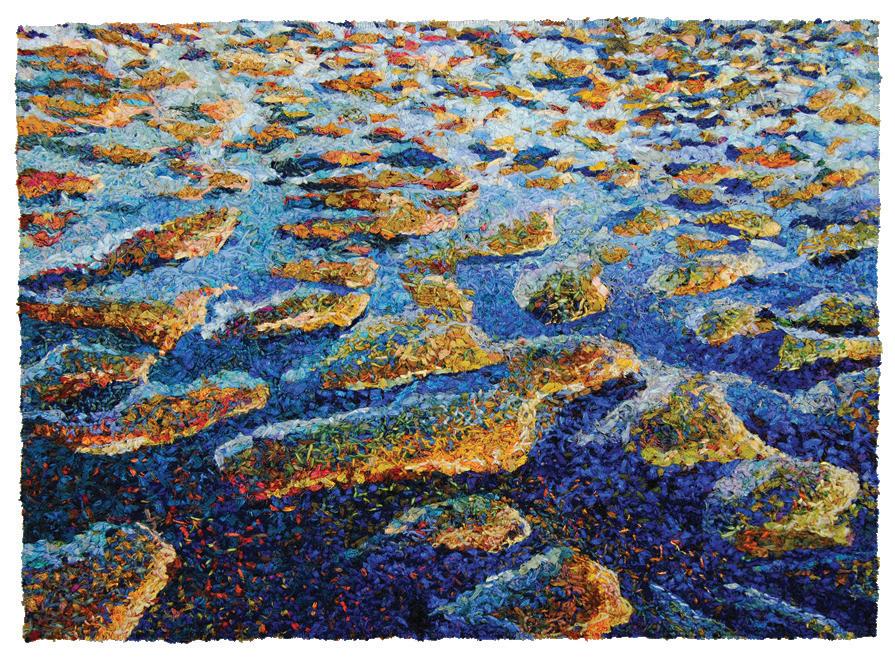
Cambridge, Massachusetts, USA
www.sandygregg.com



Detroit, Michigan, USA
www.charris-design.com
57 x 39 inches (145 x 99 cm) | 2016
Grand Junction, Colorado, USA
sandrahoefner.com
Winter Trees
21 x 5 inches (53 x 11 cm) | 2017

Michelle Jackson
Sandia Park, New Mexico, USA
www.quiltfashions.com
Pelican Rescue 47 x 50 inches (119 x 127 cm) | 2017


Murrysville, Pennsylvania, USA www.pattykz.com
Steel Town: First Shift
48 x 77 inches (122 x 196 cm) | 2016


Mooresville, North Carolina, USA
www.bluemoonriver.com
Crystalline
40 x 40 inches (102 x 102 cm) | 2016
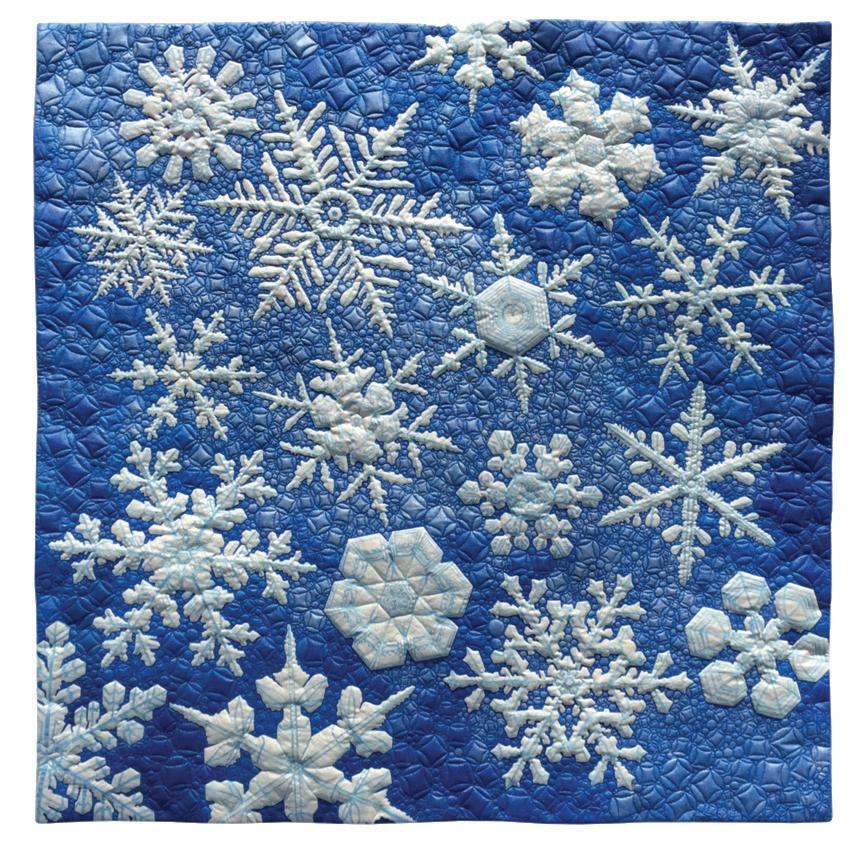
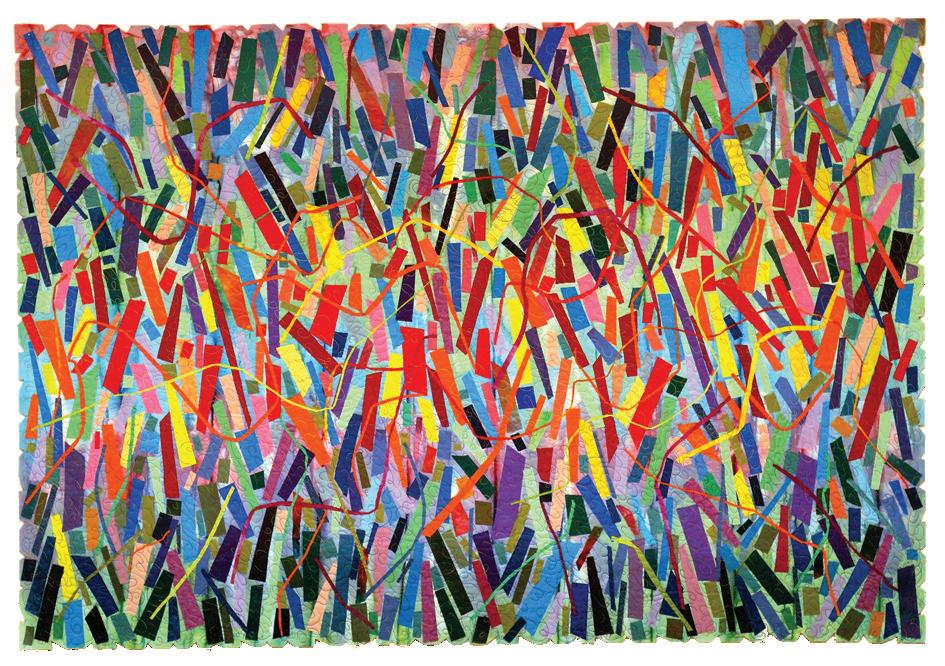
Freising, Germany
www.barbaralange.com
53 x 29 inches (135 x 75 cm) | 2016




Falmouth, Massachusetts, USA
www.weefolkstudio.com


Fredericksburg, Virginia, USA
www.loriemccown.com
Wells, Somerset, UK
www.aliciamerrett.co.uk
The Long (English) Village
55 x 28 inches (140 x 71 cm) | 2016




Fortuna, California, USA www.katiepm.com
Graffiti V
44 x 42 inches (112 x 107 cm) | 2016 private collection

Morgan Hill, California, USA www.geripkartquilts.com
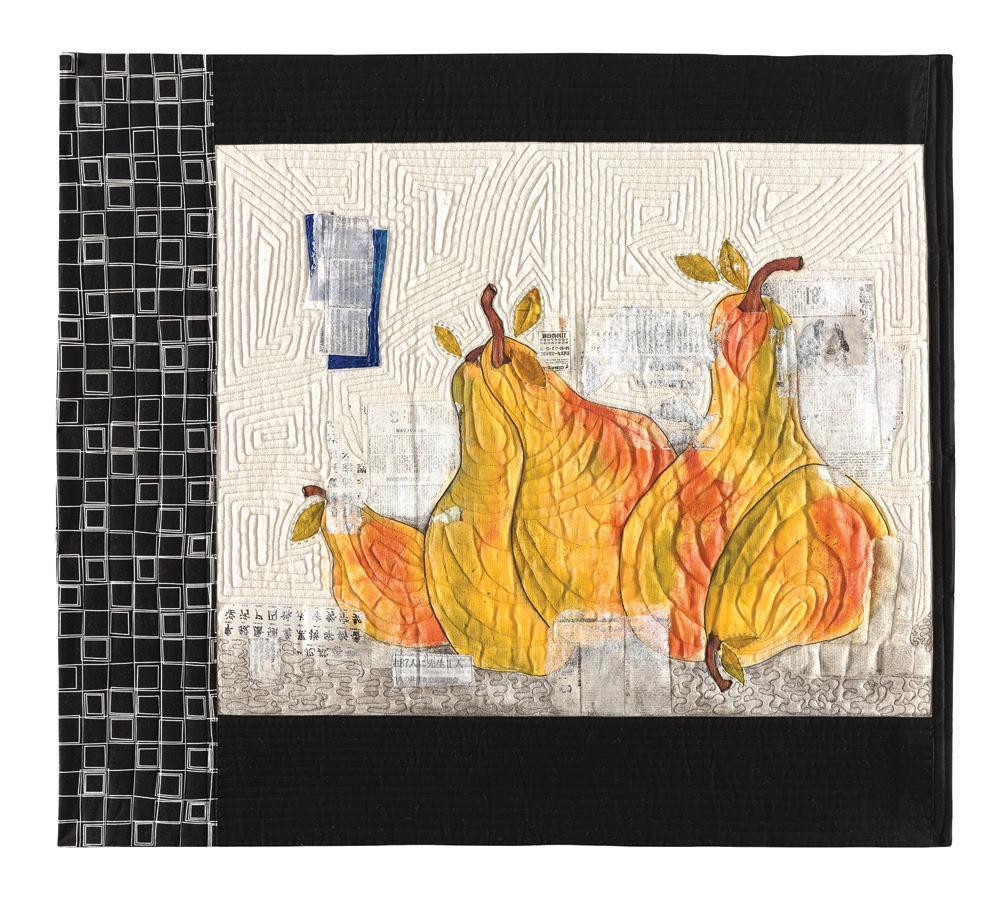
Richmond, Virginia, USA
www.juliapfaffquilt.blogspot.com

Stitches VIII
54 x 23 inches (137 x 58 cm) | 2016

Elaine
Ottawa, Ontario, Canada
www.elainequehl.com
Sporogenesis
24 x 34 inches (61 x 86 cm) | 2017

Hamburg, Pennsylvania, USA
www.martharessler.com

Kim H Ritter
Houston, Texas, USA
www.kimritter.com

That’s Sew Me!
52 x 41 inches (132 x 104 cm) | 2016


Montevideo, Uruguay
www.alisonschwabe.com
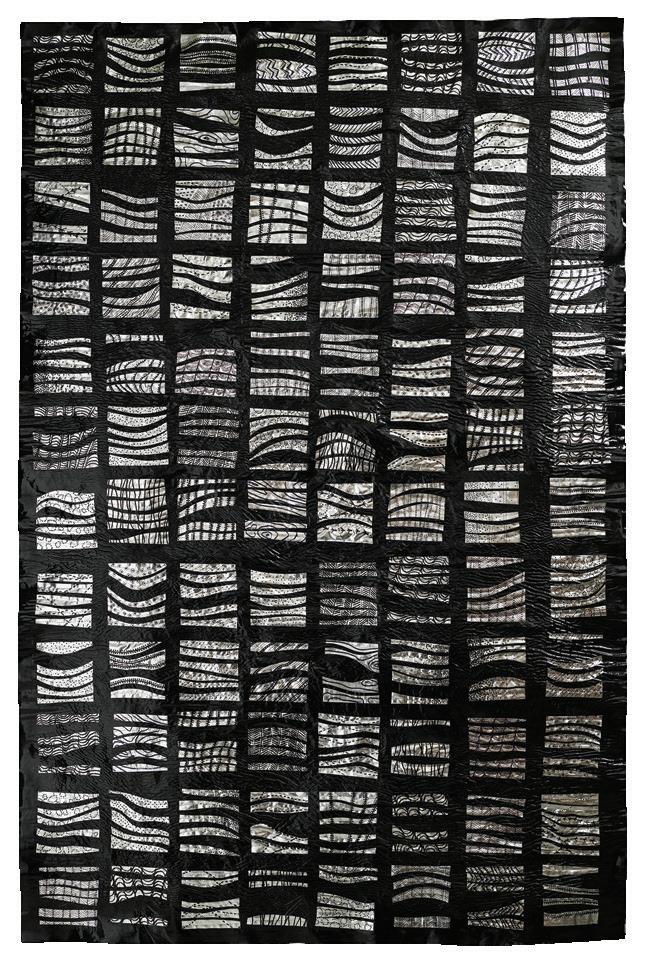
Anchorage, Alaska, USA
www.mariashell.com
HARU
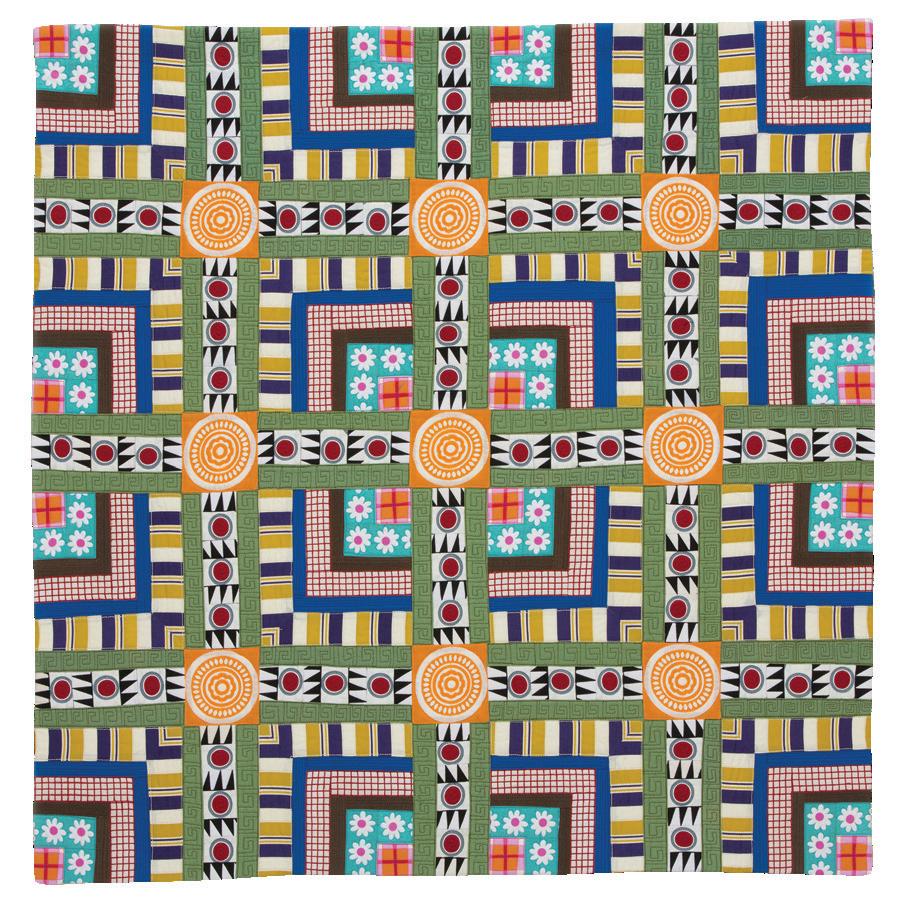

Byron, Illinois, USA
www.virginiaspiegel.com
Boundary Waters 83
40 x 40 inches (100 x 102 cm) | 2016
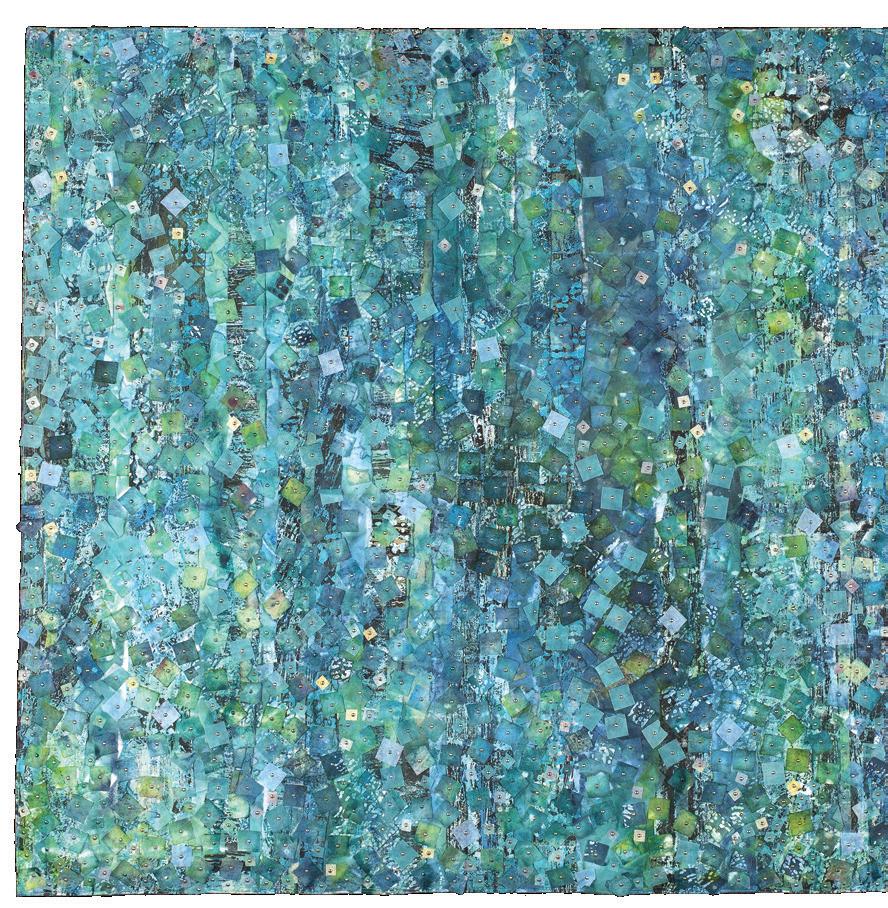

Boulder, Colorado, USA
www.judithtrager.com
Butterfly Maiden
32 x 44 inches (81 x 112 cm) | 2016
Oberwil, Switzerland
www.textileart.ch

28 x 46 inches (72 x 119 cm) | 2016
Elgin, Illinois, USA
www.artfabrik.com

Windy City #3
15 x 12 inches (38 x 31 cm) | 2017

Chapel Hill, North Carolina, USA
nancywhittington.com

Miami, Florida, USA
movinthreads.com
Kissed by the sun
42 x 49 inches (107 x 125 cm) | 2017
Charlotte Ziebarth
Boulder, Colorado, USA www.charlotteziebarth.com
Shifting Sands
53 x 41 inches (135 x 104 cm) | 2016

Macon, Georgia, USA
www.marianzielinski.com
43 x 58 inches (109 x 147 cm) | 2016

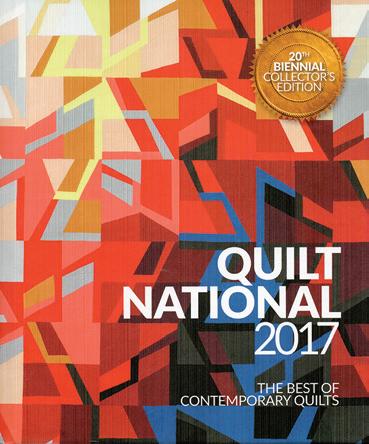
Published by The Dairy Barn Arts Center, 2017
ISBN 978-0-692-81328-7
112 pages, hard cover, full color illustrations throughout $34.95
reviewed by Patricia Kennedy-ZafredAlways highly anticipated publications, catalogs for Quilt National (QN) exhibitions are collected, treasured, and reviewed repeatedly for inspiration and artistic concepts. Quilt National 2017: The Best of Contemporary Quilts, however, is an exceptional publication, as it is the 20th Biennial Collector’s Edition and has been expanded not only to document the 2017 exhibition, but also to present the history of Quilt National and the Dairy Barn Arts Center.
The jurors Nancy Crow, one of QN’s original pioneers along with Petra Fallaux and Art Martin, were given the arduous task of evaluating 748 entries from around the world. The 85 works chosen reflect the jurors’ aesthetic inclinations, with markedly abstract quilts, some virtually popping off the pages. The quilts comprise a repertoire of surface design techniques as well as perfection in cutting, piecing, and stitching.
The history and origin of Quilt National in the late 1970s in this publication relate how artists Nancy Crow, Françoise Barnes, and Virginia Randles were determined to develop an opportunity for those creating work outside the realm of the traditional quilt show. Their efforts coincided with those of local artists, business people, and civic leaders, who were attempting to preserve the structure of what is now known as the Dairy Barn Cultural Arts Center.
As Quilt National continued to gain momentum and prestige with each passing year, due largely to the efforts of Hilary Morrow Fletcher, who became the project director in March,
1982, a position she held until her death in 2006, the founders’ instincts were proven to be correct. The Collector’s Edition also presents the cover images of all previous Quilt National catalogs and lists the jury panel for each exhibition. The juror’s statements are delightful reads, accompanied by essays from Jane Forrest Redfern, the Dairy Barn’s executive director, and Marvin Fletcher, quilt collector and board member.
Each artist’s quilt is individually featured in full color along with materials, techniques, and brief artist statements. Unfortunately, only a few detail images are offered, in the introductory pages and end papers, and it’s sometimes difficult to appreciate the artistic endeavor of larger pieces reproduced in a single page. But in page after page, the quilts speak and inform the reader. Although many of the voices are familiar, a significant number are new and noteworthy. This catalog will appeal to makers and collectors alike, making it a notable addition to your library.
Available through the Dairy Barn’s gallery shop (www.dairybarn.org)
entries. exhibitions are approspaces or their you receive a read about the SAQA exhibiunderstand certain the sizes and limited.
deeply grateful Smith, execuMuseum: Textiles; New England Sider, Texas Neuman, International Museum, for they proappointed Jose Museum 2013, she was collections, also coordinator from


2019 Exhibit: July 11-28, 2019
Call for entries: Oct. 1, 2018 – Jan. 10, 2019
2017 Traveling Exhibit: Check
www.sacredthreadsquilts.com

Birmingham (August 02-20, 2018)
Lisa Walton is leading this tour to the biggest quilt show in Europe and UK - The Festival of Quilts in Birmingham in 2018. Three full days to completely immerse yourself in the quilts, classes, demonstrations and of course shopping. After the Festival of Quilts, we will be heading to glorious Scotland where we will indulge in the passion and excitement that is Outlander. A must for avid fans of Outlander books and TV series. Our stay in Scotland in the height of the Edinburgh Festival will ensure an exciting time. Also included in this tour are visits to quilt & wool museums in Wales, a hands-on workshop with sashiko expert Susan Briscoe and an evening with award winning quilter Sheena Norquay and her quilts.
Price per person: $4,995 twin share
downsized or closed. The SAQA auction allows her to add to her collection of artists whose work she knows and admires and introduces her to artists she isn’t familiar with.

Whether to establish a relationship with the artists whose work you collect is a decision that varies by collector. For many collectors, getting to know the artists is important. Relationships with artists can lead to collaborations and friendships, she said.
Laura’s collecting process often starts with the artist rather than the work, except for pieces she purchases from the SAQA auction.
“I buy auction pieces that catch my eye,” she said. “When I buy an auction piece, I always want the artist to know I have their artwork. Contacting the artist sometimes starts a new, online relationship.”
Shirley tends not to establish relationships with the artists in her collection.
“What I do enjoy is learning about the artist, the work, and the location where the work is done,” she said. “Having a fiber-art collection is a joy to me. The process of acquiring it is a joy. As time goes by, it becomes more valuable to me because I remember what I was thinking at the time. It’s like a marker in my artistic journey, mostly of appreciation these days rather than actual art making.”
For further information please contact Opulent Journeys
Phone: 800 475 1569
Email: enquiries@opulentjourneys.com.au www. opulentjourneys.com.au

Collecting fiber art can be a satisfying experience, whether your aim is to support the art form and the artists who create it, to gain inspiration for your own work, or to decorate your walls. There are pieces to fit every

budget available through a variety of venues from the SAQA Benefit Auction to galleries to large exhibitions, such as Quilt National or Art Quilt Elements. Visit venues where fiber art is sold online and in person. Make notes of the pieces that catch your eye and look for common themes, such as color, design elements, texture and

Guns: Loaded Conversations
San Jose Museum of Quilts & Textiles


San Jose, California: April – July 2018
Layered Voices
Oklahoma State University Museum of Art
Stillwater, Oklahoma: May – August 2018
For a complete listing visit www saqa com/art
H2Oh!
New England Quilt Museum
Lowell, Massachusetts: July – September 2018
Food for Thought
George A. Spiva Center for the Arts

Joplin, Missouri: May – June 2018
For

Wreath, a quilt “bursting with verve and excitement.” Zegart also is attracted to the images of nature in the painted quilts of Gayle Fraas and Duncan Slade. Ruth McDowell’s Cod (2002), full
of movement, appeals to this Pisces, as does Swimmers by Tim Harding, where “the water comes alive” via Harding’s slashing technique.
Marilyn Henrion brings the city into sharp focus in her recent work. She uses digital imagery and her signature fine quilting to define and celebrate city life.
Finally, Zegart applauds the feminist political theme in Resistance to Tyranny Is Obedience to God, a 1995 quilt by Adrienne Yorinks commemorating the suffragette movement. She says, “Art quilts sink or swim on their beauty, their originality, and the reaction they provoke in the viewer.”

I am grateful that Shelly Zegart has shared her list of favorite artists and art quilts, along with her own reactions to this art form as a connoisseur.
www.shellyquilts.com/go/about


January 19 - April 15, 2018
A Geogr aphical Jour ney:
The Paul J. Smith Textile Collection
Without a Net: Susan Else
Talismanic Tresses: Vien Le Wood
Cambodian Dance Costumes
Shoji Tabucheese: Chuck Stolarek
April 22, 2018 - July 15, 2018
Guns: Loaded Conver sations

In Collabor ation with Studio Ar t Quilt Associates
Gener ation of Change: A Movement, Not a Moment
Quilts by the Social Justice
Sewing Academy
Pilar Agüero-Esparza
www.sjquiltmuseum.org